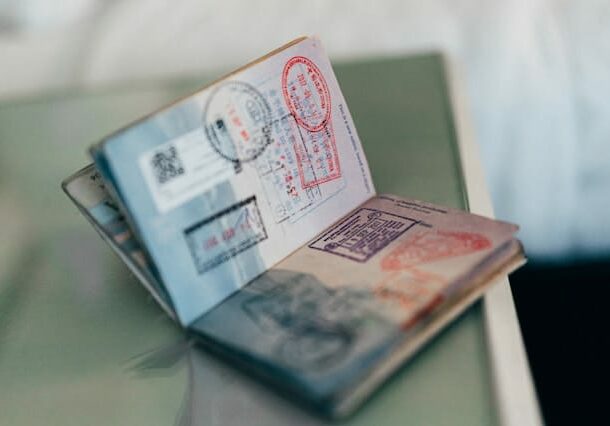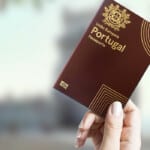The Iberian peninsula is a magical part of the Mediterranean, so it’s no wonder that thousands of people are looking into obtaining a Spanish passport.
In this ultimate guide to the Spanish passport you will learn about:
- How to get a Spanish passport
- The benefits of the Spanish passport
- How to obtain Spanish citizenship and more
About the Spanish Passport
 Types of passports
Types of passports

- Regular: The regular passport is the most common passport issued to Spanish citizens. All passports currently issued are electronic passports, also known as biometric passports. The electronic passport contains an RFID chip embedded in its back cover, capable of identifying its holders without the need for contact with the readers.
- Diplomatic: A diplomatic passport is issued to Spanish diplomats and high-ranking government officials for use on official trips. In contrast, service passports are provided to Spanish nationals working in specific government departments or public organizations on assignments abroad. Both a diplomatic passport and a service passport are valid only for the duration of the specific mission or assignment.
 Spanish passport ranking
Spanish passport ranking
The Spanish passport is presently ranked 16th on the Global Passport Index, granting visa-free access to over 100 countries. The Spain passport power is high, making it one of the world’s most coveted passports thanks to its exceptionally high mobility score, ranking 4th worldwide.
Holders of a passport enjoy the convenience of visa-free and visa-on-arrival access to numerous countries, including Brazil, Japan, the United Kingdom, the United Arab Emirates, and the United States.
This privilege enables almost immediate global travel. However, Spanish citizens need a visa for about 25 destinations worldwide, with countries like Russia being a notable example of where a visa is necessary.
Top 10 Spanish Passport Benefits
In addition to travel benefits with the Spanish passport, Spanish citizens enjoy the privileges of being part of the European Union. As an EU citizen, you have the right to live, work, and study in any EU member state, granting you access to a diverse job market, world-class education, and the opportunity to immerse yourself in the rich cultures and histories of various European countries.
Since joining the EU in 1986, Spanish citizens have enjoyed numerous benefits, which include:
- Exceptional travel mobility: The Spanish passport ranks fourth globally on the Enhanced Mobility Index. There are over 100 Spanish passport visa free countries, enhancing mobility across the globe.
- Live and work in the European Union: Spain is a member of the European Union (EU), and so the Spanish passport grants individuals free movement and the right to live, work, and study in European Union countries without the need for additional visas or permits.
- Access to high-quality healthcare: One of the main benefits of having a Spanish passport is that you become an EU citizen, granting you access public healthcare throughout Europe using your European Health Insurance Card (EHIC). The Spanish healthcare system is also fantastic, with options for private health insurance at a much lower rate than other European countries and the US.
- Safe Investments: With a stable economy and political neutrality, Spanish citizens have access to a secure and reliable investment landscape.
- Voting rights: Spanish citizens have a right to vote in elections, and if you want to make a difference in Spain, this is the way.
- Educational opportunities: Looking at the benefits of Spanish citizenship, all Spanish citizens have access to a rich and comprehensive educational system, including preschool, primary, secondary, and tertiary education.
- Consular benefits: All Spanish citizens can reach out to Spanish consulates and embassies across the world in case of any issues during their travels.
- Spanish culture and language: Also included in the benefits of a Spanish passport are the opportunities to immerse yourself in the rich Spanish culture and language.
- Retirement in Spain: If you get the passport, you have an opportunity to retire in Spain later on with almost no hassle.
- Spanish Passport Ranking: The Spanish passport has one of the highest passport rankings in the world. Ranked 21st in the Global Passport Index, the passport guarantees visa-free access to 174 countries to Spanish citizens, including on-arrival visa access to 31 countries. Additionally, you can access 24 countries with electronic visas.
As you can see, the benefits of a Spanish passport are immense. Whether you want to open doors for your family to travel, immerse yourself in the incredible Spanish culture, or start investing in EU countries, the Spanish passport offers all this and more to those who qualify.
Global Visa Requirements for Spanish Passport Holders
Spanish passports offer their holders numerous advantages, chief among them being the ability to travel to a wide range of countries without needing a visa. Below is an in-depth look at the entry conditions to various countries.
| Country | Spain |
|---|---|
| visa required | |
| visa free (90 days) | |
| visa required | |
| visa free | |
| visa free (30 days) | |
| visa free (180 days) | |
| visa free (90 days) | |
| visa free (180 days) | |
| e-visa | |
| visa free | |
| e-visa | |
| visa free (90 days) | |
| visa on arrival | |
| visa on arrival | |
| visa free (90 days) | |
| visa free (30 days) | |
| visa free | |
| visa free | |
| e-visa | |
| e-visa | |
| visa free (90 days) | |
| visa free (90 days) | |
| visa free (90 days) | |
| visa free (90 days) | |
| visa free (90 days) | |
| visa free | |
| visa on arrival | |
| visa on arrival | |
| visa on arrival | |
| e-visa | |
| e-visa | |
| visa free (30 days) | |
| visa required | |
| visa required | |
| visa free (90 days) | |
| visa free (15 days) | |
| visa free (90 days) | |
| visa on arrival | |
| visa required | |
| e-visa | |
| visa free (180 days) | |
| e-visa | |
| visa free | |
| visa required | |
| visa free | |
| visa free | |
| visa free | |
| e-visa | |
| visa free (180 days) | |
| visa free | |
| visa free (90 days) | |
| visa on arrival | |
| visa free (90 days) | |
| e-visa | |
| visa required | |
| visa free | |
| visa free (30 days) | |
| visa on arrival | |
| visa free (120 days) | |
| visa free | |
| visa free | |
| visa free (30 days) | |
| visa free (90 days) | |
| visa free (360 days) | |
| visa free | |
| visa on arrival | |
| visa free | |
| visa free (90 days) | |
| visa free (90 days) | |
| e-visa | |
| visa on arrival | |
| visa free (90 days) | |
| visa free (90 days) | |
| visa free (90 days) | |
| visa free (90 days) | |
| visa free | |
| visa free | |
| e-visa | |
| visa on arrival | |
| e-visa | |
| visa on arrival | |
| visa free | |
| visa free (90 days) | |
| visa free | |
| visa free (90 days) | |
| visa free (90 days) | |
| visa on arrival | |
| visa free (30 days) | |
| e-visa | |
| visa free (90 days) | |
| visa on arrival | |
| visa free (60 days) | |
| visa on arrival | |
| visa free | |
| visa on arrival | |
| visa free (14 days) | |
| visa required | |
| visa required | |
| visa free | |
| visa free | |
| visa free | |
| visa free (90 days) | |
| visa on arrival | |
| visa on arrival | |
| visa free (90 days) | |
| visa on arrival | |
| visa required | |
| visa free | |
| visa free (90 days) | |
| visa on arrival | |
| visa free (90 days) | |
| visa free (180 days) | |
| visa free (90 days) | |
| visa free (90 days) | |
| visa free | |
| visa free (30 days) | |
| visa free (90 days) | |
| visa free (90 days) | |
| visa free (30 days) | |
| e-visa | |
| visa free (90 days) | |
| visa required | |
| visa on arrival | |
| visa free | |
| e-visa | |
| visa free (90 days) | |
| visa required | |
| e-visa | |
| visa required | |
| visa free (90 days) | |
| visa free | |
| visa on arrival | |
| e-visa | |
| visa free (90 days) | |
| visa free | |
| visa free (90 days) | |
| e-visa | |
| visa free (90 days) | |
| visa free (90 days) | |
| visa free (30 days) | |
| visa free | |
| visa free | |
| visa on arrival | |
| visa free | |
| e-visa | |
| visa on arrival | |
| visa free (90 days) | |
| visa free (90 days) | |
| visa free (90 days) | |
| visa free | |
| visa free (15 days) | |
| visa on arrival | |
| visa free (90 days) | |
| visa free (90 days) | |
| visa free (90 days) | |
| visa on arrival | |
| visa free (90 days) | |
| visa free | |
| visa free | |
| visa free (90 days) | |
| visa on arrival | |
| visa free (90 days) | |
| visa free (90 days) | |
| e-visa | |
| e-visa | |
| visa free (90 days) | |
| visa required | |
| visa required | |
| visa free | |
| visa free | |
| visa required | |
| visa free (90 days) | |
| visa free (30 days) | |
| visa on arrival | |
| visa free (30 days) | |
| visa free (90 days) | |
| visa on arrival | |
| visa free (90 days) | |
| visa free (90 days) | |
| visa free (90 days) | |
| visa required | |
| visa free (90 days) | |
| visa free (90 days) | |
| e-visa | |
| visa free (90 days) | |
| visa free (90 days) | |
| visa free (180 days) | |
| e-visa | |
| visa free (90 days) | |
| visa free (30 days) | |
| visa free (90 days) | |
| visa free | |
| visa free (90 days) | |
| visa free (45 days) | |
| visa required | |
| visa free (90 days) | |
| visa on arrival |
Spanish Passport Eligibility Criteria
To be eligible for a Spanish passport, you must first become a Spanish citizen. There are several pathways to obtaining Spanish citizenship, typically involving ten years of being a Spanish resident.
There are various routes under the Spanish system, for acquiring Spanish nationality (whereby you can get a passport). We’ll explore all of them below.
1. Spanish citizenship by descent
If you have a close family connection with Spanish relatives, you can obtain Spanish citizenship by descent (Democratic Memory Law program). This includes individuals born to a Spanish mother or Spanish father, and having a Spanish grandparent (specifically grandchildren of Spanish women born in Spain and married to non-Spanish citizens before 1978). This process is called Spanish Citizenship by Descent, and includes not only people who have Spanish parents but also those who are under the care of a Spanish national or were adopted and are over 18 years old.
2.Spanish citizenship by discretionary conferral
Here, Spanish citizenship is granted at the discretion of the Government by Royal Decree. The person concerned must prove that there are exceptional circumstances warranting the granting of nationality, such as reasons relating to culture, sport, science, solidarity, etc.
3. Spanish citizenship by possession of status
This is an unusual route for acquiring Spanish nationality based on the person who possessed and used Spanish nationality for ten years. The person concerned must have possessed and used Spanish nationality in good faith, and a record of nationality must be held in the Civil Register, even if that record is annulled.
4. Spanish citizenship by naturalization
This is, without doubt, the most common naturalization procedure foreign nationals use to obtain Spanish citizenship. This route requires that the applicant is a Spanish resident for between 2-10 years depending on their individual circumstances. For example, those born in Ibero-American countries, France, Portugal, Andorra, Equatorial Guinea, and the Philippines are eligible for Spanish citizenship after two years. However, most foreign nationals only qualify after ten years of residency in Spain.
5.Spanish citizenship by investment
Spain does not offer a direct citizenship-by-investment program. Unlike some other countries, Spain doesn’t grant citizenship purely based on a financial investment. However, Spain does have a residency-by-investment program, commonly referred to as the “Golden Visa” program. This program can eventually lead to citizenship, but it requires a longer process, including a period of residency, as well as a significant financial investment in Spain through real estate or business investment.
Process of Getting the Spanish Passport through Investment
Launched in 2013, the Spain Golden Visa Program gives investors and their families the incredible opportunity to get long-term residency in the country. However, the Golden Visa does not directly lead to citizenship.
After living in the country for five years, you can apply for permanent residency, and then to apply for citizenship, you need to have been a legal resident in Spain for ten years.
You must also maintain the investment for the duration of your residency. Additionally, you need to spend a certain amount of time in Spain each year to renew the residency permit. Apart from the investment, there are application fees, legal fees, and processing fees. These can vary depending on the complexity of your case and the professionals you engage with.
Investment options
Several investment routes are available to investors, such as:
- Investing a minimum of €500,000 in Spanish real estate (you are free to invest in multiple properties)
- Making a bank deposit of at least €1 million into a Spanish bank account
- Investing at least €1 million in shares of Spanish businesses
- Contributing €2 million towards government bonds
- Starting a business in Spain and investing €1 million, with the business generating employment and contributing to technological/or scientific innovation, or having a strong socioeconomic impact.
The initial visa is valid for one year. After this, the residence permit is valid for three years. This residence permit can then be renewed every five years. After you’ve been domiciled in the country for five years, you can apply for permanent residency. Permanent residence is an important step towards Spanish citizenship.
Note that applicants are required to visit Spain to submit their biometric data.
Minimum stay requirements
To be eligible for Spanish citizenship through the Spanish Golden Visa program, an applicant must hold a residence permit and spend at least 183 days per year for ten years in Spain.
To obtain Spanish nationality through the Spain Golden Visa program, you need to fulfill a few stay requirements.
- You must have been a Spanish resident for ten years
- Applicants must have resided in Spain for at least six months per year throughout that time to qualify
However, for individuals from former Spanish colonies and territories, Spanish citizenship can be obtained within two years by meeting the minimum stay policy of the Spanish government.
Spanish residency through the Golden Visa
The Golden Visa grants you and your family members residency in Spain. Initially, the residency visa is issued for three years and can be renewed for five-year periods as long as the investment is maintained. Once you and your family have remained residents of Spain for ten years you may be eligible for citizenship and a Spanish passport.
Spanish Passport Requirements
Applying for a Spanish passport requires following steps and fulfilling specific requirements. Before starting the application process, ensure you meet the passport requirements. To be eligible for a passport, you must be a Spanish citizen by birth, naturalization, or other means.
Required documents for the Spanish passport

- A valid Spanish ID card (DNI) or, if you don’t have one, your Spanish nationality certificate
- Proof of payment of the passport application fee, which is €30 for the regular passport
- For minor children or individuals under legal guardianship, additional documentation will be required, such as parental consent or a court order granting permission to apply for a passport.
- Two recent, identical passport-size photos (32 x 26 mm) with a white and smooth background. The face must be fully frontal and without dark glasses or any other clothing that could prevent the identification of the person (the photograph must clearly show the oval of the face, which includes eyebrows, eyes, nose, mouth, and chin, and must be in high resolution and on good quality photographic paper).
All Spanish citizens have the right to obtain an ordinary passport as long as any of the following circumstances do not apply:
- Having been sentenced to penalties or security measures that entail the deprivation or limitation of their freedom of residence or movement.
- When the judicial authority has prohibited its issuance or departure from Spain.
- This right is not limited by the Ministry of Interior due to states of alarm, exception, and siege.
How to Get a Spanish Passport: Step-By-Step Process
- Schedule an appointment: You must schedule an appointment at your local police station or the nearest Spanish Consulate or Embassy if you are living abroad. Appointments can typically be booked online or by phone. Ensure you arrive on time and bring all the required documents with you.
- Submit your passport application form and documents: A government official will review your documents and take your biometric data (digital photos and fingerprints) during your appointment. You will also be asked to verify your personal information before submitting your application.
- Pay the application fees: You must pay the passport application fee at the time of submission. The fee can be paid in cash or by credit/debit card, depending on the location. Ensure you keep the receipt as proof of payment. The cost of a passport is €30. This fee must be paid at the time of the passport application.
- Collect your passport: You will be notified once your application has been approved and your passport is ready for collection. Bring your receipt and any identification documents required for collection.
Fast-track application for former Spanish colony citizens

Suppose you are from an Ibero-American country (which includes most former Spanish-speaking colonies in South America), Andorra, the Philippines, or Equatorial Guinea. In that case, you only need two years of residency in Spain to obtain citizenship.
The Spanish government has recently updated its guidelines, allowing applicants to exit Spain multiple times while still fulfilling the stay requirements for citizenship. Ultimately, applicants needs to visit Spain every two to three months over two years, working out to eight visits.
Spanish Passport Cost
At present, the Spanish government charges a standard fee of €30 for issuing a first passport, as well as for replacing or renewing an existing one. This fee can be paid in cash directly at the passport issuing office, or alternatively, it can be paid online using the “Telematic” service.
Dual Citizenship in Spain
Spain allows dual citizenship for nationals from specific countries, such as Ibero-American countries (most Latin American countries, including Brazil), Andorra, the Philippines, France, Equatorial Guinea, and Portugal. Citizens of these countries can keep their original nationality while obtaining Spanish citizenship.
However, Spain generally does not permit dual citizenship for citizens of other countries not mentioned above. In these cases, individuals may be required to renounce their original citizenship when obtaining Spanish citizenship.
Spanish Passport Renewal
If you need to renew your Spanish passport, go to the Spanish Ministry of Foreign Affairs or your local police (Garda) station. It’s important to schedule an appointment online.
But if you’re abroad, in another country, you’ll need to find and visit a Spanish embassy or consulate.
Required documents for renewing the Spanish passport
When renewing your passport, you’ll need the following documentation:
- Current or expired passport (in case your passport was stolen, you need to provide a police report too from a police station)
- Valid Spanish D.N.I
- Three photographs of 3 x 4 cm that aren’t older than six months
- Renewal fee which is €30
Spanish passport renewal waiting time
It generally takes about a month to renew your passport. Start by popping into a passport office if you’re in Spain. If you’re elsewhere, an embassy or consulate will do. Fill out your application with great care and gather all the necessary documents.
Renewing a lost, stolen, or damaged Spanish passport
If your passport’s gone missing, been nicked, is about to expire, or has seen better days, you can sort out a new one at the Spanish Ministry of Foreign Affairs. Bring your valid national ID and the passport you need to replace. If you lack these papers, the consular office might be able to confirm your Spanish citizenship by contacting the authorities back home. Just a heads-up, though: if it goes down this route, your new passport might only be good for three weeks. This short window gives you a chance to round up the proper additional documents for Spanish authorities.
Renewal cost
Renewing your Spanish passport costs €30.
How to renew a Spanish passport in the USA
To renew your Spanish passport in the USA, you need to follow these steps:
- Schedule an appointment with the Spanish Consulate that has jurisdiction over your area of residence. You can typically book an appointment online or by phone.
- Gather the required documents, including your current Spanish passport, Spanish ID card (DNI), and two recent passport-size photos with a white background
- Attend your appointment and submit the required documents, pay the application fee, and have your biometric data (digital photo and fingerprints) taken.
- Once your application is approved, you will be notified when your new passport is ready for collection at the Spanish Consulate.
Do I need to live in Spain to obtain Spanish citizenship?

- Initial visa period: The Golden Visa initially allows you to live in Spain for one or two years.
- Renewals: You can renew this visa for two additional five-year periods.
- Physical presence requirements: The Spanish Golden Visa requirements include remaining in Spain for a minimum of 183 days per year for at least five years.
- Path to permanent residency and citizenship: If you aim to acquire permanent residency or Spanish citizenship, the requirements change. For permanent residency, you must live in Spain for five years. For citizenship, you generally need to be a resident for ten years. However, this period can be shorter in some specific cases (like for refugees or nationals from Ibero-American countries, Andorra, the Philippines, Equatorial Guinea, or Portugal).
Is It Worth Having a Spanish Passport?
It is absolutely worth it to have a second passport from Spain. Not only will you and your family members be able to live, work, and study in one of the best European countries, but your worldwide opportunities will broaden with visa-free access to over 100 countries worldwide.
Becoming a Spanish citizen not only provides practical advantages such as visa-free access to a high standard of living within the EU but also opens doors to cultural experiences, business opportunities, and a stable political environment. Additionally, the option for dual citizenship allows for flexibility.
How Can Global Citizen Solutions Help You?
Global Citizen Solutions is a boutique migration consultancy firm with years of experience delivering bespoke residence and citizenship by investment solutions for international families. With offices worldwide and an experienced, hands-on team, we have helped hundreds of clients worldwide acquire citizenship, residence visas, or homes while diversifying their portfolios with robust investments.
We guide you from start to finish, taking you beyond your citizenship or residency by investment application.

Frequently Asked Questions about the Spanish Passport
What are the benefits of having a Spanish passport?
There are multiple Spanish passport benefits, including, visa-free access to over 100 countries, the right to live, work, and study in Spain and other EU countries, and the entire family being included, granting permanent residency, and eventually a passport to spouses and dependents.
How long does it take to get a Spanish passport?
For Spanish citizens, the passport application takes about a month. For those obtaining Spanish citizenship, it takes ten years to become a Spanish national through residence, or two years if you’re from a Latin American country or a former Spanish colony.
How to get a Spanish passport by descent?
If you have Spanish ancestry, you can apply for a Spanish citizenship by descent and a Spanish passport by obtaining proof of your Spanish heritage. The steps include:, gathering required documents, scheduling an appointment at your local Spanish consulate or the Civil Registry in Spain if you reside there, submitting the application, waiting for approval, obtaining citizenship, and applying for your Spanish passport.
Can a US citizen get a Spanish passport?
A US citizen can get a Spanish passport only if they obtain Spanish nationality first. This can be achieved through naturalization, marriage to a Spanish citizen, or by proving Spanish descent. Once Spanish citizenship is acquired, the individual can apply for a Spanish passport.
How hard is it to get a Spanish passport?
The difficulty of obtaining a Spanish passport depends on your circumstances and eligibility. Generally, the process requires meeting specific criteria such as residency, language proficiency, and a clean criminal record. The process can be more straightforward for individuals with Spanish ancestry or those married to a Spanish citizen as you can apply for citizenship after one year of marriage and joint residency.
Can I get a Spanish passport without living in Spain?
In most cases, you need to live in Spain for a certain period to obtain Spanish citizenship and, subsequently, a Spanish passport. However, if you have Spanish ancestry, you might be eligible for citizenship by descent without living in Spain.
How do I track my Spanish passport application status?
The easiest way to track your Spanish passport application is through the Spanish Ministry of Foreign Affairs Website. This can be found through their free online platform “cómo va lo mío”.
How long is a Spanish passport valid for?
In general, the passport will have a non-extendable validity of:
- Two years when the applicant has not reached five years of age.
- Five years if the holder is under thirty on the date of issue.
- Ten years when the holder has reached the age of thirty.
Is the Spanish passport stronger than the USA one?
Based on the Global Passport Index, the Spanish passport ranks 21st and the US passport ranks 2nd. However, based on the enhanced mobility index the Spanish passport comes in 4th while the US comes in 17th. This means if you’re looking for more mobility and the opportunity to travel to other European countries in the Schengen area, Spain is the better option.
What are the fees associated with applying for a Spanish passport?
This depends on where you are in the Spanish citizenship application process. If you are already a Spanish citizen then a passport costs €30. If you need to apply for Spanish citizenship then the cost with vary based on the citizenship route you take.
Is there a Spanish citizenship test?
Yes, for foreign nationals that want to obtain Spanish citizenship they must pass the CCSE (Constitutional and Sociocultural Aspects of Spain) test and the Spanish Language Test (DELE A3 or higher).



